From a valuation standpoint I think it's a good idea to map some things out. Let's dive into the concept that the company will get the LME to work (they likely will not but let's model). Bondholders take the haircuts, preferred shares are cancelled out, DTL is half offset with NOA leaving us with $565M to still deal with (none of us are in the room and know what tax outcomes will be in 2029/2030 so going conservative here), I will assume $1,570M LITNA debt stays but will value the DTL at half value since at maturity it’s offset, $92M in minority interest, $2,900M revolver. For the LME I am stating 65% payout for 2027-2028, 60% payout for 2029, and 50% for 2034-2068 which will cost QVC Group $1,150.90M (without consent fees, transaction costs, and legal factored) leaving them ~$721.10M in cash which is then subtracted.
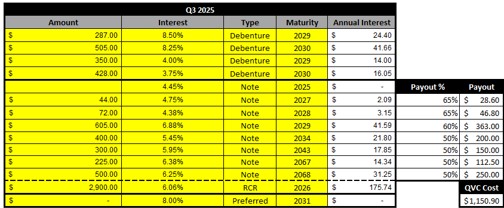
This gives us a valuation base somewhere around ~$4,405.90 in the LME QVC Group. Now the trading multiple will still be around 5x as the secular decline in cable is still a problem and with $2,900M drawn on bank credit, and even rolling into new paper for facility pay-down, leaves them with a risky DEBT/EBITDA. This is also aligned with historical multiples for the group.
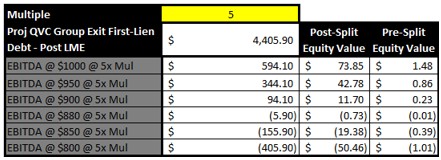
The company made $2,146M disappear off the books and has a cash interest savings of $132.08M annually plus they also made $1,270M in preferred equity go away which will also save $101M annually. Issue here is the $101M is kind of a non-issue for QVC, Inc because the will pay the parent a dividend regardless and whatever the parent did with the cash was the parents use and currently QVC, Inc has been restricted and the dividend they pay to parent has not included preferred coverage.
At 5x multiple the equity is still pretty much worthless at $900M EBITDA but I suppose at $950M EBITDA that’s enough for some QVCGA holders who bought in at $0.60 to feel there’s a path to recovery, especially as many kept DCA on the way down. Problem is this is not really a real-world value creation for the company thus making the LME less likely to happen given what it would cost to execute. A 5x multiple is also within historical limits for QVC and given their main distribution path is in secular decline, EBITDA is not stable, I do not see them getting beyond a 5x even post LME as earnings would not support. We can see have much $50M of EBITDA swings the valuation.
If I do model a 6x though we do see some equity value created from this move, but the risk is still EBITDA being unstable and this making cash flows volatile. 6x is unlikely to be achieved.
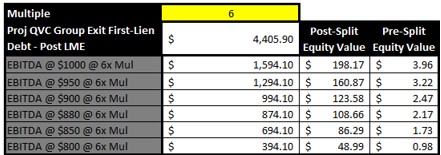
And the other risk as I mentioned is credit facility, with $2,900M drawn, gets refinanced in post-LME world with a higher rate. Given leverage is still high, bond holders just got haircuts, and EBITDA is still in decline, ratings agencies will likely not upgrade them meaning pricing of debt will be in their B/CCC+ ratings and where SOFR is + B spreads I would expect them to be +9% and I currently model 9.055% (9.06% rounded). This drastically changes the interest savings the company would receive as well:
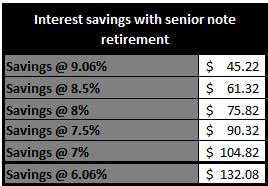
If interest does go to ~9.06% @ $2,900M drawn we're talking only a $45.22M cash savings from this LME. Hardly beneficial if EBITDA declines constrain FCF generation. The issue is not their ability to service their debt, but the revolver draw and refinance of the revolver in October 2026 and secular decline of their distribution platform challenging the refinance. An LME does not solve these problems and even if it worked the value creation is not enough.
As I wrote below TJ also grossly misunderstands the distressed creditor framework and while the company could solicit consent this is not bankruptcy (yet) so each debt group is their own chess piece on the board and each would need > 50% to vote in favor to make this work. Here is where I believe TJ does not understand the creditor framework. Taxes sure, distressed debt? I am not seeing it. The senior QVC, Inc bond holders are pari passu and all are on equal footing. If they're only getting a $0.50-0.60 offer then perhaps they feel as a group they can get more as a going concern. Maybe the 2027-2029 are open to cash offers, but the later stuff is likely in a different game. Until bankruptcy, when they would be grouped into a single class, each is their own man.
For covenants to be stripped you would need > 50% to vote for this in order to cram the rest to convert their paper. Seven players needing > 50% each. Even in the 2027-2028 exchange there were holdouts swapping into 2029. Assuming no one is going to hold out here is a large mistake by anyone holding QVCGA. If we had hold outs in a out of court exchange last year what do we think is going to happen now?
I also brought up before, but will mention again, most of this stuff (especially LITNA) is likely marked-to-market so while some of what he states is correct it's also important to note these are likely already a loss on these funds books on paper. Once they actually sell the position for a loss there is a possible tax loss asset here for them. My point being some of these holders are not as distressed as one may assume.
And while bond prices may be down I think this also is a misunderstanding of the way these bonds move. Under certain prices some of these funds are forced to sell and selling begets more selling thus pushing the bond prices down. Distressed debt is a fun game. These specific situations also create opportunity. I call this out because the debt may be in distressed pricing ranges but this can be an effect of forced fund selling.
Let’s switch gears and if we take just QVC, Inc (OpCo) and assume chapter 11 then what I see happening is revolver will likely be made whole in rolling over. My assumption here is QVC will work with banks and likely convert some of this to DIP not for financing reasons, QVC has the money already, but to curry favors and move the banking syndicate to super priority. No sense torching relationships with JPM, Bank of America, and others. Small world and these folks will likely do business with them again. Even if they leave QVC.
Now QVC, Inc has $1,305M in cash ($330M + $975M) and let's just assume 20% is lost in this bankruptcy bringing it already down to $1,044M. This already is not as flexible as many are thinking. If QVC put $500M into paying down some of the revolver balance in bankruptcy and they come out of bankruptcy with $2,400M this leaves them with $544M to fund the business in the new reorg. The rest of the senior notes from 2027-2068 are debt-for-equity swapped. Below is my breakdown also considering a 10% eat into EBITDA from bankruptcy.
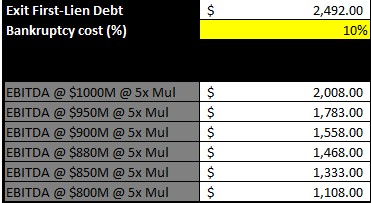
The above analysis shows that there may indeed be value in bond holders fighting more more and not taking a haircut.
From here though you can see there is no value to upstream to Liberty Interactive and certainly not to QVC Group. I am struggling to make it work as is and it's very likely a 4.5x multiple will be used here which lowers value further. And again, the above was without dilution factored. Even if Liberty got 5% in warrants these would be further diluted with MIP, rights, and various other things. QVC Group owns Liberty Interactive which only owns a stub of QVC the asset. No more cash dividend either to QVC Group. What does this make QVCGA worth? Assuming they don't file at the same time or shortly after and equity isn’t cancelled out.
And I want to again highlight the fact that Liberty Interactive made that promissory note to QVC Global for $1,740M. While there is no money to exchange here what this is, is an asset that will be used in bankruptcy. It will reinforce these are separate structured companies AND it will show the parent actually owes OpCo money. Even if a multiple was used to upstream value for equity warrants, this almost guarantees there will be nothing.
As it stands below is my position is in QVCD. It is risky as there are so many moving parts, but this is closest to the real value asset - QVC, Inc. I also see $132.08M savings just from senior notes being new equity, another $45.28M in revolver pay-down at ~9.06%, and QVC, Inc will not longer pay the upstream dividend so another +$108M savings. My current position and what I attempt to value it at in a new org:

Now this is impacted by multiples that get used, +/- on bankruptcy costs, +/- MIP, rights/backstops/GUC, and whatever else I am missing. That stated, this is my position and math into future value. In a post-reorg this will also likely have a higher multiple as well which would change things, but I am going conservative.
Now some other risks are the new org may not go public but I would think the new org goes public and/or gets acquired shortly after. Will have decent cash flows again from what I stated above, still does over $5B in revenue, leaner balance sheet. If it goes public there's likely dilution but that's not going to change the valuation too much. Other risks as well I am weighing.
In short, I do not see an LME as a way for QVC to get out of their situation. I see chapter 11 as the most probable outcome and QVCGA will be worthless upon this move. There is not enough value to support passing to Liberty and nothing to pass from Liberty to QVC Group where QVCGA sits. For me, this is why I am less focused on going into technicals on the DTL or even the preferreds. The value is at the OpCo and that value is not enough to make QVCGA the 100x I see many consider it to be.
The current company moves also signal to me that an LME is not in the cards. The below are all typical moves seen before a filing is to occur.
- March 7th 2025 – FITCH downgraded QVC Group to B-.
- May 23rd, 2025 – Company halts preferred dividend.
- May 27th, 2025 – Reported company hired Evercore, Inc and Kirkland and bondholders hired PJT Partners and David Polk.
- May 29th, 2025 – LITNA holders Centerview and Akin Gump.
- May 30th, 2025 FITCH Downgraded QVC Group to CCC+.
- June 20th, 2025 – Company brought on Roger Meltzer and Carol Flaton as board members paying $50K a month.
- August 7th, 2025 – Company drew $975M from their credit facility after the quarter period. It was announced but did not actually hit the balance sheet.
- August 13th, 2025 – Reported bank syndicate had 75% on board and hired Simpson Thacher & Bartlett.
- August 15th, 2025 – Company filed an 8-K announcing their internal legal teams
Happy investing,
-Sean |










